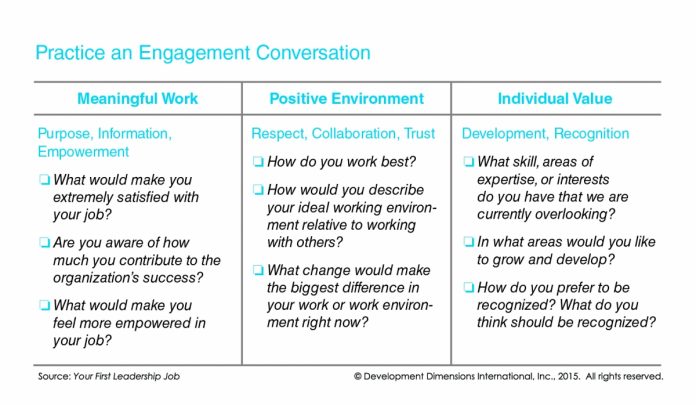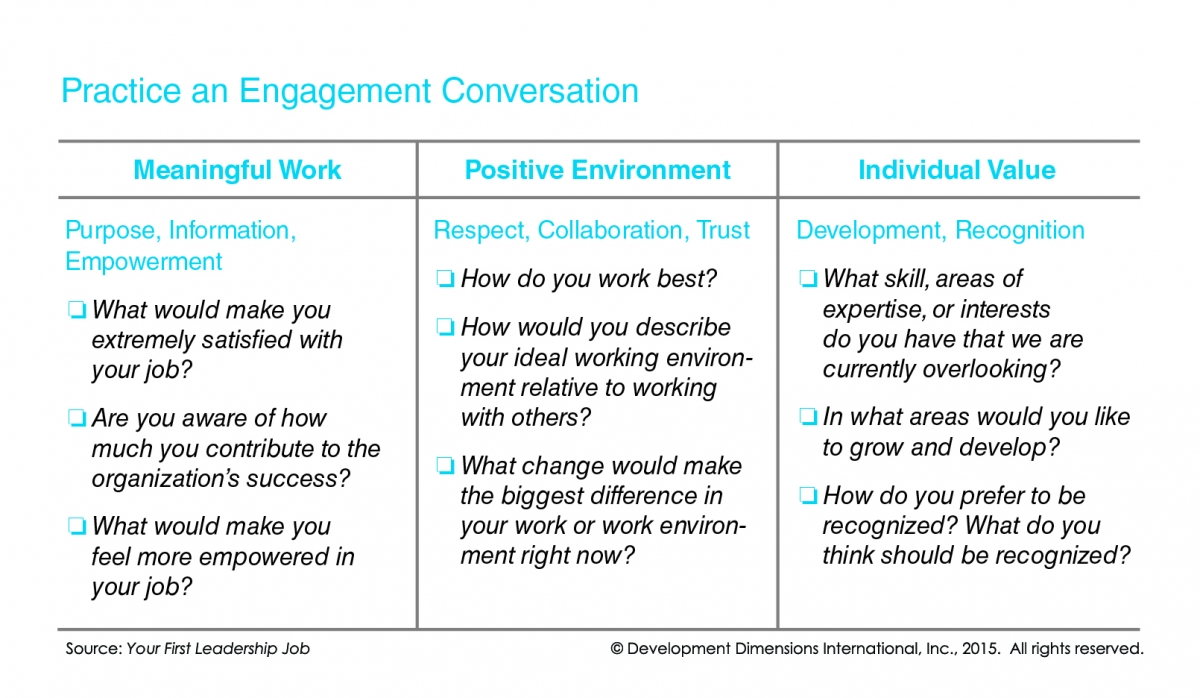
Plans to expand across the globe. A laser-like focus on double-digit growth. Aggressive strategies to drive innovation, attain a dominant market share, or contain costs. Organizations differ in what they are trying to do and where they are trying to take their business. But none are successful unless they have engaged employees.
The quest for engaged employees evokes questions such as:
- Are people showing up energized and ready to work?
- Are people feeling hopeful about the future?
- Are people bringing their best effort to the table?
And having engaged employees isn’t enough. You also need to retain them, a reality that elicits questions such as: Are employees happy enough to stick around? Or are you always looking for new people?
There are hundreds of studies showing groups with highly engaged teams are more profitable and productive (based on their stated business goals), have more satisfied customers, and suffer fewer accidents. What’s more, losing, replacing, and then training new employees costs businesses and the global economy billions of dollars every year. But the cost to the economy is not the hot issue here.
No organization can afford a culture where unhappiness thrives. Nor can their leaders—at any organizational level. This also goes for new leaders who may lack the perspective and skills to make engagement and retention priorities as they settle into leading a team for the first time.
THE POWER OF THE LEADER
It’s tempting for first-time leaders to think they don’t have much power to keep employees from jumping ship for other jobs or companies. And to a certain extent, that’s true. Some overarching features that attract talent—such as the company mission and strategy, benefits, and other perks—are out of the hands of individual leaders. But according to a 2014 study by The Conference Board, Deloitte, and Sirota, the opposite is true: “Leaders who are expected and empowered to build engagement” was among the factors that defined highly engaged organizations.
When people show up for work feeling strong and full of enthusiasm, they develop a loyalty that makes them want to push through obstacles, bring new ideas to the table, and do their part to help the company meet its goals. And they stick around. This reality puts leaders in the driver’s seat in a meaningful way. By authentically speaking to the hearts and minds of their team and colleagues, leaders are more likely to drive higher levels of commitment, energy, and loyalty. Indeed, it’s an important truth: Few people leave a job; they leave a leader.
Consider this all-too-familiar story we heard from a former data analyst named Tara excerpted from my book, “Your First Leadership Job,” cowritten with Rich Wellins, Ph.D.:
It wasn’t until my third week on the job that I realized my manager didn’t remember my name. Worse, he thought I was someone else. Sure, we were both women and had blonde hair, but that was where the similarity ended. By the end of the second month—and eight excruciating staff meetings later—it was clear he didn’t know who any of us really were or what we were doing. And he didn’t care beyond the reports we filed. I was gone before the ninth staff meeting.
Engaged employees find meaning in their work and know they are growing and developing. This wasn’t the case for Tara. A leader’s job is to create the best environment for that to happen. To create that environment, leaders need the skills to continually identify how to keep their people engaged before they lose their drive. A common description of leadership is getting work done through others. Engagement is the way leaders do that.
Here are three examples of how leadership and engagement are intertwined:
- When a leader delegates tasks with an eye to helping teams develop, those people have a real chance to gain experience and grow their skills.
- Leaders must focus on the why whenever they can. When they share the connection between the tasks people do and the company’s goals, team members see where they fit into the big picture. Explaining the reasons behind something employees consider routine—such as a monthly report—helps people understand why their role is valuable to the greater whole.
- When leaders get good at coaching people along the way—before there’s a problem—those people feel valued, protected, and ready to take on the next challenge.
The single highest driver of employee engagement is whether or not workers feel their managers are genuinely interested in their well-being. But as Mark C. Crowley points out in an article on Fast Company’s Website, only about 40 percent of workers actually believe that to be true.
WHAT DRIVES ENGAGEMENT AND RETENTION
When people are empowered and passionate about their work, their productivity, morale, and, ultimately, business performance increase significantly.
Leaders can increase employee engagement by addressing three factors that get to the heart of what matters to people and their job satisfaction. We’ve found these categories to be largely true for most humans, regardless of generation, gender, job type, race, nationality, or geography.
We call them engagement and retention drivers, and they are fairly straightforward. They are:
- Individual Value—I’m appreciated and encouraged to grow.
- Meaningful Work—What I Do Metters
- Positive Environment—This is a great place to work.
Part of a leader’s role is to help his or her people identify their source of job and career satisfaction. Through an ongoing series of engagement conversations, leaders can help their people make the connection between what fulfills them and the work they do. Then it’s up to the leader to create an environment where team members can thrive and grow by overcoming any obstacles they might be experiencing.
One area where new leaders can get tripped up is that they can fail to understand each person on the team might need something different from the leader in order to be successful. Understanding the engagement drivers can help with that.
The figure below lists the drivers, work values they represent, and a list of questions you might ask your team members during individual engagement conversations.

Front-line leaders have a direct influence on every one of the drivers just mentioned. Not only that, but they are also personally influential. Their people naturally look to them to provide direction and support for day-to-day work. But they also need their leaders to recognize their unique needs, capabilities, and potential. The leader’s voice will set the tone for the entire group.
The Employee Engagement Spectrum
When it comes to their level of engagement, employees fall into one of three categories. By building an energetic environment that enables employee engagement, leaders can help ensure their team members stay in the “engaged” category.
The ENGAGED employee is positively charged, passionate, optimistic, and brimming with ideas.
The STUCK employee operates in neutral, is checked out, has low energy, and does the bare minimum, but isn’t leaving. He or she slows everyone else down.
The DISENGAGED employee is negatively charged, complains, spreads discontent, and causes conflict. He or she typically leaves, often with a bang.
Tacy M. Byham, Ph.D., is CEO of Development Dimensions International (DDI). A passionate speaker, she shares her personal journey and the collective wisdom from DDI’s experience across 26 countries to explore what it means to #LeadLikeAGirl and unleash the confidence and potential of women. She is co-author, with Richard S. Wellins, Ph.D., of “Your First Leadership Job: How Catalyst Leaders Bring Out the Best in Others” (Wiley, 2015; http://www.ddiworld.com/books/yourfirstleadershipjob) from which this article was adapted.


